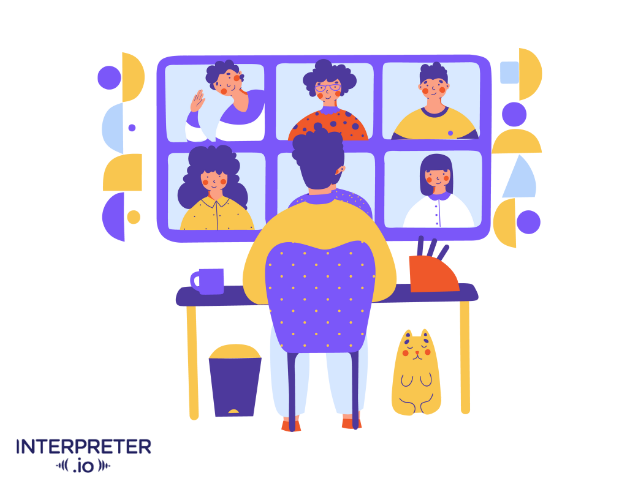Video Interpreting Services: Enhancing Accessibility and Understanding
Interpreting services come in many forms, each catering to different needs and situations. From in-person interpreters who assist face-to-face, to telephonic interpreters who provide support over the phone, the world of language interpretation is diverse.
In this article, we're going to focus on a specific type of interpreting service that has gained prominence with technological advancements: video interpreting services. We will explore what video interpreting service is, how it operates, and where it is most effectively used.
What is a Video Interpreting Service?
A video interpreting service is a digital platform that facilitates communication between people who speak different languages. It involves connecting with a professional interpreter via a video call.
This service is practical in situations where in-person interpretation is not possible or practical. The use of video allows for visual cues, which can be particularly beneficial in contexts where non-verbal communication is important, such as in sign language interpretation.
This service has practical applications in various fields. In healthcare, for instance, it enables patients and medical staff to communicate effectively when they do not share a common language. In legal settings, it ensures that all parties can understand proceedings, regardless of language barriers. Businesses also use video interpreting to facilitate cross-border meetings and negotiations.
The interpreters in these services are typically certified and have expertise in specific language pairs and fields. They are trained to handle the technical aspects of video calls and to manage the challenges of interpreting without being physically present. They adhere to standards of accuracy, confidentiality, and professionalism.
The Rise of Video Interpreting
 The significant leap forward came with the internet and video technology advancements. High-speed internet made video streaming more reliable and accessible, leading to the growth of video interpreting services. These services started to gain traction as they offered a viable solution to immediate interpreting needs in various contexts, like hospitals, courts, and international conferences.
The significant leap forward came with the internet and video technology advancements. High-speed internet made video streaming more reliable and accessible, leading to the growth of video interpreting services. These services started to gain traction as they offered a viable solution to immediate interpreting needs in various contexts, like hospitals, courts, and international conferences.
A key factor in the evolution of video interpreting has been the increasing need for quick, accurate, and accessible language services in a globally connected world. Businesses, healthcare providers, and legal systems, among others, have increasingly encountered scenarios where clear and immediate cross-language communication is crucial. Video interpreting services emerged as a response to this need, providing a platform where language barriers could be bridged swiftly and effectively.
The COVID-19 pandemic further accelerated the adoption of video interpreting services. With the sudden shift to remote work and the need for social distancing, organizations and individuals increasingly turned to digital solutions for communication.
Video interpreting services proved invaluable in this context, offering a safe and efficient way to maintain multilingual communication without physical contact.
Real-world applications of video interpreting are abundant. For example, Interpreter IO offers video interpreting services that cater to various industries, demonstrating the wide applicability and growing demand for these services.
How Video Interpreting Services Work
Video interpreting services simplify language translation through a digital platform. Let's break down how they function in practical terms:
The Technology Behind the Scenes
These services operate on digital platforms, often accessible through a website or a mobile app. The key components include a reliable internet connection, video software, and audio equipment. Interpreters and users connect via these platforms for a video call. The technology used ensures that the video is clear and the audio is crisp, making the conversation as smooth as possible.
Process and Protocols
Here's the step-by-step process:
Requesting an Interpreter: Users log into the service's platform and request an interpreter, specifying the required languages and any other relevant details, like the subject matter.
Matching with an Interpreter: The service then matches the user with an available interpreter who has the right language skills and subject matter expertise. This matching is often automated, ensuring quick and efficient pairing.
During the Session: In the interpreting session, the interpreter listens to the speaker, then translates and relays the message in the target language. They focus on accuracy, ensuring that both the meaning and context of the original message are preserved.
Feedback and Quality Control: After the session, users may be asked to provide feedback on the service. This helps maintain quality standards and improve the service.
Industries Benefiting from Video Interpreting Services
The use of video interpreting services has become increasingly common in various sectors, each with its unique communication needs. Let's look at some key industries where these services play a vital role.
Healthcare
In healthcare, clear communication is critical. Video interpreting helps doctors and nurses talk to patients who speak different languages. This improves understanding during medical appointments and treatments. For instance, during the COVID-19 pandemic, video interpreting was crucial in hospitals for communicating with patients while maintaining safety protocols.
Legal/Courts
The legal sector needs accurate communication. Courts use video interpreting to help non-English speakers understand and participate in legal processes. This is important for ensuring everyone's rights are respected. Police departments also use these services to talk clearly with people during investigations and community interactions.
Businesses/Agencies
 Businesses use video interpreting for meetings and negotiations with international partners. This helps them communicate effectively across different languages. Companies also use it during international conferences, helping attendees from various countries participate in discussions.
Businesses use video interpreting for meetings and negotiations with international partners. This helps them communicate effectively across different languages. Companies also use it during international conferences, helping attendees from various countries participate in discussions.
Call Centers
Some businesses use video interpreting in customer service to help customers who speak different languages. This makes it easier to solve their problems and answer their questions, which can improve customer satisfaction.
Key Features of Quality Video Interpreting Services
Choosing a video interpreting service involves looking closely at their key features. These features are not just added benefits but essential components that ensure the service is effective, reliable, and suitable for your specific needs.
Qualified Interpreters
The effectiveness of a video interpreting service largely depends on the skills of its interpreters. These professionals should be fluent in their languages and knowledgeable in specific sectors like healthcare or law. Their expertise ensures accurate and contextually appropriate translations.
Security and Confidentiality
Given the often sensitive nature of conversations, a good video interpreting service must prioritize secure communication. This involves using encrypted connections and complying with privacy laws to protect user data. For instance, in the United States, adherence to HIPAA regulations is critical for maintaining patient confidentiality in healthcare.
User-Friendly Interface and Support
Ease of use is important. The service should allow quick access to interpreters without complicated procedures. Effective customer support is also essential, providing assistance for any technical issues to ensure uninterrupted service.
Technological Reliability
The service's technology should support clear audio and video communication. Good video and sound quality are essential to avoid misunderstandings, especially in critical situations. Regular updates and maintenance are necessary to keep the system functioning efficiently.
Accessibility Features
The service should be accessible from various devices, making it easy to use from different locations. Features like closed captioning and sign language interpretation are important for inclusivity, catering to users with hearing impairments.
Flexible Scheduling
The ability to schedule sessions flexibly, including on-demand services, accommodates different user requirements. Whether for planned or unexpected needs, the service should offer various scheduling options.
Choosing the Right Video Interpreting Service
Picking a suitable video interpreting service requires careful consideration of several practical factors:
Reliability and Availability
Firstly, you must check the service's uptime and reliability. A good service should have minimal downtime and be readily available when you need it. This is crucial for urgent or unplanned interpreting needs.
Technical Features and User Experience
Examine the technical aspects of the service. It should be easy to use and support features that enhance the interpreting experience, like clear audio and video quality, and if needed, features for sharing documents.
Security Measures
Security is important, especially for confidential or sensitive matters. Ensure the service adheres to industry standards for data protection and privacy.
Future Trends in Video Interpreting Services
The evolution of video interpreting services is closely tied to advancements in technology and the changing requirements of a global audience. Here's what we can anticipate in the near future:
Expanding Global Reach
As internet connectivity improves globally and technology becomes more affordable, video interpreting services are expected to become more accessible, especially in remote and underserved regions.
This expansion is vital for communities that currently have limited access to professional interpreting services, enabling them to utilize these services for essential purposes like education, healthcare, and legal matters.
Customization and Personalization
Customization is likely to play a significant role in the future of video interpreting services. We can expect these services to offer more personalized experiences, adapting to specific industries or user preferences.
This might include customizable user interfaces, features tailored for particular sectors, or adaptive algorithms that learn and adjust to the preferences and styles of users and interpreters.
Conclusion
Video interpreting services are essential in today's world where multiple languages are often used in the same space. These services provide a straightforward solution to the language barriers encountered in various settings, from business to healthcare.
Implementing an industry-leading video interpretation platform, such as Interpreter IO, guarantees a strong commitment to precision and dependability, while maintaining the high standards of customer service that are often compromised by other platforms.
Whenever you are organizing international business conferences, medical consultations, or court proceedings, don't hesitate to contact us. You can get in touch either by sending an inquiry.
